Today in Gallery History
On February 18, 1968, French Painting 1900-1967 opened at the National Gallery of Art. The exhibition, which was intended to bring attention to the work of artists of the School of Paris, came at a time of strong sentiment against the French and President Charles de Gaulle and received poor reviews.
Highlights of the Gallery's History
1928 | 1931 | 1935 | 1936 | 1937 | 1939 | 1940 | 1941 | 1942 | 1943
1944 | 1946 | 1947 | 1948 | 1949 | 1950 | 1952 | 1953 | 1956 | 1958
1962 | 1963 | 1966 | 1967 | 1969 | 1971 | 1973 | 1974 | 1976 | 1977
1978 | 1983 | 1984 | 1985 | 1986 | 1988 | 1990 | 1991 | 1992 | 1995
1996 | 1997 | 1998 | 1999 | 2000 | 2001 | 2002 | 2003 | 2004 | 2005
- 1928
- Secretary of the Treasury Andrew W. Mellon first writes of his interest in establishing a national art museum in the nation's capital.

- 1931
- Mellon completes his purchase from Soviet officials of 21 masterpieces from the Hermitage Museum, including Raphael's Alba Madonna.
- 1935
- Mellon commissions architect John Russell Pope to make the first sketches for the National Gallery of Art at a site on the Mall in Washington.
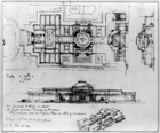
- 1936
- On December 22, Mellon writes to President Franklin D. Roosevelt, offering to donate his art collection to the nation and to build the National Gallery of Art.
- 1937
- Congress passes legislation to establish the National Gallery of Art as an independent bureau within the Smithsonian Institution.
- During the summer, construction of the building for the new museum begins.

- 1939
- Samuel H. Kress and the Samuel H. Kress Foundation donate 375 Italian paintings and 18 works of sculpture, the first major addition to the Gallery's collection.
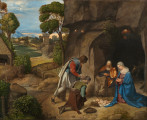
- The Gallery loans three paintings from the Mellon collection to the Golden Gate International Exposition and three to the New York World's Fair, the first loans made by the new museum.
- 1940
- Construction of the museum's building is completed in December and installation of works of art begins.
- 1941
![[real audio file]](https://cybercemetery.unt.edu/archive/oilspill/20130218071045im_/http://www.nga.gov/images/real_a2.gif) (Download RealPlayer)
(Download RealPlayer) - The National Gallery of Art is dedicated on March 17 by President Roosevelt at evening ceremonies attended by 8,822 guests.
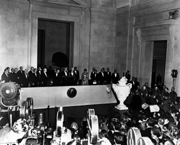
- The museum's first special exhibition, Two Hundred American Watercolors, opens on May 15.
- Nightly black-outs of the Gallery building for air-raid protection begin on December 7.
- 1942
- The Gallery's most valuable paintings and sculpture are evacuated to Biltmore House in North Carolina for wartime protection.

- The Gallery remains open Sunday evenings for the "benefit of men in the armed forces and war workers in the city." Sunday evening orchestra concerts are presented through the generosity of Chester Dale.
- Joseph Widener donates the Widener collection of more than 600 works of art in memory of his father, Peter A. B. Widener.
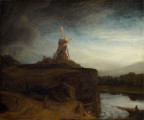
- 1943
- Lessing J. Rosenwald donates approximately 8,000 prints and drawings, his first major gift to the museum. His gifts eventually include 22,000 prints and drawings.
- The American Commission for the Protection and Salvage of Artistic and Historic Monuments in War Areas (the Roberts Commission) is organized, with its headquarters in the museum.
- 1944
- The first annual American Music Festival is held on Sunday evenings during March and April in the East Garden Court.

- Works of art are returned to the Gallery from wartime storage at Biltmore House.
- 1946
- Six new exhibition galleries are completed for the special opening exhibition of the Kress collection.
- 1947
- The A. W. Mellon Educational and Charitable Trust gives to the Gallery 113 portraits from the Clarke collection, with the provision that some works may be transferred to a national portrait gallery, should one be established.

- 1948
- Nearly one million people see 202 paintings from Berlin Museums during a forty-day exhibition at the National Gallery of Art.
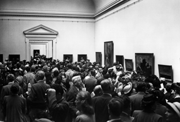
- 1949
- A key set of about 1,500 photographs by Alfred Stieglitz is given by Georgia O'Keeffe, executor of the Stieglitz estate.
- 1950
- Twelve new exhibition galleries are opened on the east side of the museum building.
- 1952
- The first annual Andrew W. Mellon Lectures in the Fine Arts take place in the spring.
- 1953
- William and Bernice Chrysler Garbisch give 142 paintings from their collection of early American art.

- 1956
- In celebration of the Gallery's 15th anniversary, a special night opening is held for the Exhibition of Paintings and Sculpture Acquired by the Samuel H. Kress Foundation.
- 1958
- The innovative LecTour radio guide system is installed in several main- floor galleries.
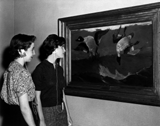
- 1962
- Chester Dale dies, bequeathing his collection to the National Gallery of Art.
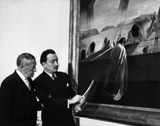
- 1963
- The Mona Lisa is exhibited, lent by the Government of the French Republic to the President and people of the United States.

- 1966
- In honor of the museum's 25th anniversary, the Gallery exhibits 19th- and 20th-century French paintings from the collections of Mr. and Mrs. Paul Mellon and Ailsa Mellon Bruce.
- 1967
- Leonardo da Vinci's Ginevra de' Benci is acquired through the generosity of the Ailsa Mellon Bruce Fund.

- Paul Mellon and Ailsa Mellon Bruce donate funds for the new East Building.
- 1969
- I. M. Pei & Partners begin East Building schematic drawings.

- 1971
- Ground-breaking ceremonies are held for the East Building.
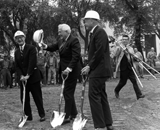
- 1973
- Forty-one French impressionist paintings from the Soviet Union are exhibited, the first Western paintings from the Hermitage and Pushkin Museums ever allowed to leave the USSR for the United States.
- 1974
- The Exhibition of Archaeological Finds from the People's Republic of China is seen by more than 700,000 people.
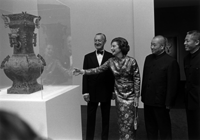
- 1975
- The Collectors Committee is established to enable the Gallery to carry out a three-year program of large-scale commissions of works of art for its new East Building.
- 1976
- The exhibition Treasures of Tutankhamun begins its United States tour at the Gallery, where it is viewed by more than 835,000 visitors.
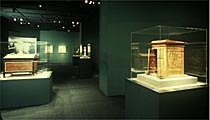
- 1977
- The untitled mobile by Alexander Calder, commissioned for the East Building, is installed in the atrium of the new building nearly a year after the artist's death.
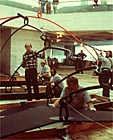
- 1978
![[real audio file]](https://cybercemetery.unt.edu/archive/oilspill/20130218071045im_/http://www.nga.gov/images/real_a2.gif) (Download RealPlayer)
(Download RealPlayer) - The East Building is dedicated and opened to the public. Attendance reaches one million in less than two months.
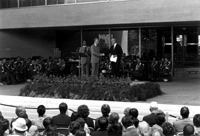
- 1983
- New ground-floor galleries in the West Building are opened to the public.
- 1984
- The West Building oculus project is completed, allowing the Rotunda to be seen from the Constitution Avenue lobby below.
- 1985
- The exhibition Treasure Houses of Britain: 500 Years of Private Patronage and Art Collecting is seen by nearly one million viewers.
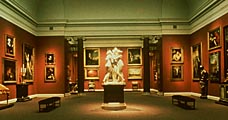
- Mr. and Mrs. Paul Mellon make a major donation to the National Gallery of 186 objects, including 17 wax sculptures by Edgar Degas.
- 1986
- The New Painting: Impressionism 1874-1886 commemorates the 100th anniversary of the last exhibition held by the impressionist painters.

- 1988
- The 10th anniversary of the opening of the East Building is celebrated with a new installation of the Gallery's 20th-century collection.
- 1990
- The masterpiece by Giovanni Bellini and Titian, The Feast of the Gods, is returned to public view after four years in the Gallery's conservation laboratories.

- 1991
- The museum's 50th anniversary is celebrated with an exhibition of nearly 300 works of art, given or pledged to the Gallery in honor of the occasion.
- Circa 1492: Art in the Age of Exploration opens in commemoration of the quincentenary of Columbus' voyage to the Americas.
- 1992
- The Woodner Family Collection of old master drawings and the Dorothy and Herbert Vogel collection of minimal and conceptual American art are given to the Gallery.

- 1995
- In its twentieth year, the Collector's Committee acquires Cy Twombly's Untitled (Bolsena) for the 20th-century collection.
- The Micro Gallery, a multi-media interactive computer system, opens in the redesigned Art Information Room in the West Building.
- The Dutch Cabinet Galleries, three new galleries to house small Dutch and Flemish paintings, are completed.
- 1996
- A several-year project to replace West Building skylights begins. During the project, portions of the permanent collection are relocated from the main floor to the ground floor.
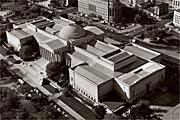
- The exhibition Johannes Vermeer attracts extraordinary crowds and overwhelming public response.
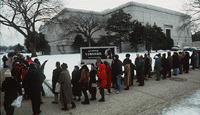
- 1997
- The Gallery opens its World Wide Web site, which includes a database of information about works of art in the collection.
- Ground-breaking takes place for the National Gallery Sculpture Garden adjacent to the West Building on the Mall. The Sculpture Garden is given to the nation by The Morris and Gwendolyn Cafritz Foundation.
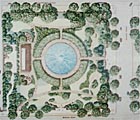
- 1998
- Betsey Cushing Whitney, widow of John Hay "Jock" Whitney, bequeaths eight important paintings by major artists to the Gallery, including Self-Portrait by Vincent van Gogh.
- Van Gogh's Van Goghs: Masterpieces from the Van Gogh Museum, Amsterdam, an exhibition of 70 paintings by the Dutch artist on loan from the Van Gogh Museum, Amsterdam, attracts capacity crowds.
- 1999
- The museum mourns the death on February 1 of Paul Mellon, son of the founder Andrew Mellon and a preeminent leader and patron of the National Gallery of Art since serving as its first president in 1938.
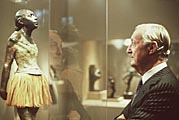
- The National Gallery of Art Sculpture Garden is dedicated on May 23. First Lady Hillary Rodham Clinton accepts the completed garden on behalf of the nation.
- 2000
- The new Italian Cabinet Galleries open on the West Building main floor. The rooms are designed to evoke the small private chambers of the Renaissance.
- In November, a redesigned ice-skating rink opens to the public in the National Gallery of Art Sculpture Garden.
- 2001
- On March 17, the National Gallery of Art celebrates its sixtieth anniversary.
- The National Gallery of Art publishes its first online catalogue raisonné of more than 1,900 print and sculpture editions created at the Gemini G.E.L. workshop.
- 2002
- Redesigned sculpture galleries open on the West Building ground floor presenting more than 900 works of art in 22 exhibition rooms.

- 2003
- The 25th anniversary year of the East Building is marked with special programs and tours and an archival installation.
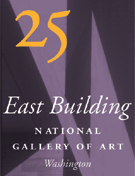
- 2004
- The National Gallery presents the 2,500th in its series of free Sunday concerts, which began in December 1942.
- 2005
- British artist Andy Goldsworthy completes his sculpture Roof on the ground level of the East Building. Designed specifically for its site, the work consists of nine hollow domes of stacked slate.

- The 76-foot-long mobile, Untitled, created in 1976 by Alexander Calder for the East Building, is reinstalled in the atrium following conservation treatment.
- 2006
- The Circle of the National Gallery of Art, a national membership group founded to support acquisitions and programs, celebrates its 20th anniversary. In honor of the event, Still Life with Grapes and Game, c. 1630, by Frans Snyders is acquired through The Lee and Juliet Folger Fund.
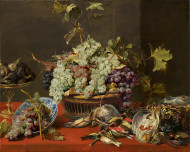
- 2007
- Rembrandt's Titus is on view from May to September, launching a series of exchanges between the Gallery and the Norton Simon Foundations in Pasadena, California.
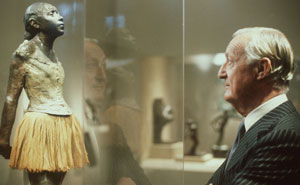
The centenary of the birth of the museum's greatest benefactor, Paul Mellon, is celebrated with exhibitions on Eugène Boudin and J. M. W. Turner, a new film about Paul Mellon's life, a historical installation, and other special programs.- 2008
A national gift program is launched, The Dorothy and Herbert Vogel Collection: Fifty Works for Fifty States. Under the program 2,500 works selected by the Vogels from their collection of contemporary art are distributed to art institutions in each of the fifty states.
In the fall, sculptor Leo Villareal's computer-programmed digital light project Multiverse is installed in the Concourse walkway.

